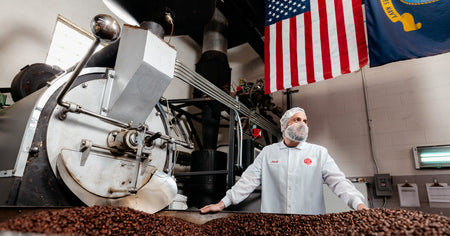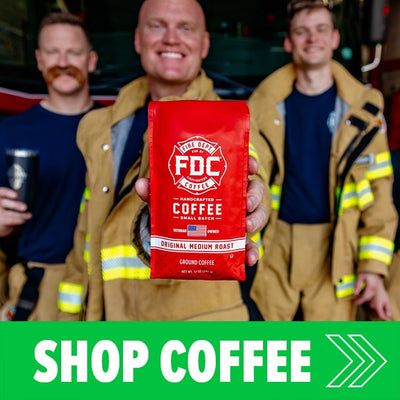November 18, 2020
Why settle for a bland or burnt caffeine shot when you can brew barista-style coffee? Yes, you. We’re not kidding. Not sure about how to make coffee taste good at home since it always seems to lack that special something? These simple tricks will take your brew from ‘average’ to ‘I’ll take two gallons of that, please.’
7 tips on how to make coffee taste good at home every single day
1. Grind your beans or use fresh grounds

Wondering why your coffee is never as flavorful as the one from your local coffee shop? Simple: they use the freshest beans, you use store-bought coffee that was roasted and ground months ago. Ouch.
Basically, once the coffee is roasted, the degassing process begins. As well as gases like CO2, the beans lose the volatile compounds responsible for flavors. The grinding process? It speeds it up even more.
To avoid this terrifyingly bland scenario, invest in a burr grinder to grind your own beans or get freshly-roasted grounds delivered on a regular basis. Of course, we’ve got a coffee subscription to cater to both!
2. Use pure water

Coffee beans are the star of the show, but coffee still consists of… 98% water. Crazy to overlook it, right? If your tap water is hard and full of chemicals like chlorine, it’s probably what’s been messing up your extraction.
Since a small concentration of certain minerals can actually help achieve a fuller taste, the best solution is installing a softening filter in your faucet or using a filtering pitcher.
3. Avoid boiling temperatures

Hey, since when can you no longer boil water to make coffee?! Well, you can, but it’ll scorch your beans and lead to over-extraction, translating into a burnt and bitter taste.
The optimal brewing temperature is actually between 195 and 205°F (90-95°C). We recommend investing in a variable-temperature kettle or using a thermometer.
If you really, really can’t be bothered (you sure?), wait 30 seconds after boiling it. But how can you ensure that if you’re using an automatic dripper? This leads us to the next point.
4. Invest in a reliable coffee maker

Take a good look at your coffee maker and consider whether or not it’s time to upgrade it. Be honest! This is particularly important if you rely on automatic drippers. Some of the cheapest plasticky models can’t even reach the required brewing temperature, resulting in a weak, under-extracted carafe, and some others might burn your coffee grounds.
This doesn’t mean that you must invest a fortune in a model with lots of customizable features. If you don’t need them, focus on a simple coffee maker that guarantees the correct brewing temperature.
A bonus? A pre-infusion mode to let your coffee degas in a manual pour over fashion.
5. Use a scale

We’ve all chucked some grounds in a basket or French press, added some water, and hoped for the best. However, if you really want to make coffee taste good at home, it’s essential to use the correct ratios and weighing both grounds and water.
While they change depending on the brewing method, a 1:15 coffee-to-water ratio for drip and 1:2 for espresso are handy starting points.
6. Tweak a variable at the time

If you aren’t too impressed with the result, don’t just do everything differently or, worse, give up. Many variables influence extraction, from grind size to temperature and ratios: only change one of them until you get the perfect coffee! Here’s our guide to understanding extraction and making the right changes.
7. Clean your equipment regularly (for real!)

We know, it’s easy to forget or be lazy about it, but, if your equipment is full of oils or old grounds, it will compromise the final taste of your coffee. Both your grinder and coffee maker (yes, even French presses!) must be cleaned regularly and the latter descaled.
Now that you know how to make coffee taste good at home, get ready to be mindblown when you brew your next cup! Don’t forget the first tip, though: get the best coffee beans or grounds delivered as frequently as it suits you.
Leave a comment
Comments will be approved before showing up.
Also in Fire Department Coffee News

Standing with Laurel County After an EF4 Tornado

FDC Featured In Nationwide Walmart Commercial and Celebrates Community Roots in Rockford

Rescue-1 Deploys to Texas: Fire Department Coffee Supports Communities After Catastrophic Flooding

Celebrating America’s Firefighting Presidents

Fire Department Coffee and Kidde Working Together to Promote Fire Safety

From Barista to Coffee Expert: Fire Dept. Coffee's Jacob Ball Brews Success

Get to Know the Hilarious, Hardworking Team Behind FDC Videos

From Fan to Family: How Lance Woodruff Became an FDC Star

Marine, Musician, Firefighter: Josh Kennedy is Doing It All

FDC Mobilizes Rosenbauer Fire Truck for Tennessee Tornado Relief

Fire Dept. Coffee's First Retail Shop Opens in Rockford, IL

Sugar Cookie Rum Infused Coffee - Spirit Infused Coffee Club
FOLLOW OUR JOURNEY, GET SPECIAL OFFERS AND PROMOTIONS
- SPIRIT INFUSED COFFEE
- Bourbon Infused Coffee
- Whiskey Infused Coffee
- Rum Infused Coffee
- Spirit Infused Coffee Club
- Spirit Infusion Process
GEAR
© 2025 Fire Department Coffee, Inc.











